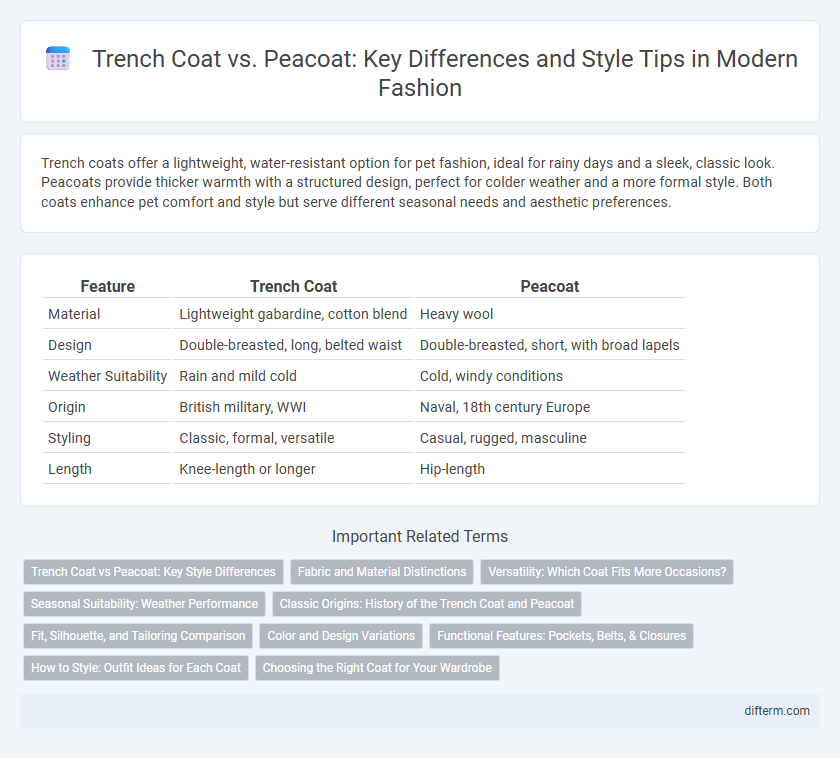Trench coats offer a lightweight, water-resistant option for pet fashion, ideal for rainy days and a sleek, classic look. Peacoats provide thicker warmth with a structured design, perfect for colder weather and a more formal style. Both coats enhance pet comfort and style but serve different seasonal needs and aesthetic preferences.
Table of Comparison
| Feature | Trench Coat | Peacoat |
|---|---|---|
| Material | Lightweight gabardine, cotton blend | Heavy wool |
| Design | Double-breasted, long, belted waist | Double-breasted, short, with broad lapels |
| Weather Suitability | Rain and mild cold | Cold, windy conditions |
| Origin | British military, WWI | Naval, 18th century Europe |
| Styling | Classic, formal, versatile | Casual, rugged, masculine |
| Length | Knee-length or longer | Hip-length |
Trench Coat vs Peacoat: Key Style Differences
Trench coats feature a lightweight, water-resistant fabric with a belted waist and double-breasted front, ideal for transitional weather and a polished, classic look. Peacoats are typically made of heavy wool, boast a shorter length, broad lapels, and large buttons, providing warmth and a structured silhouette perfect for colder climates. The trench coat's sleek, elongated design contrasts with the peacoat's more rugged, casual style, making each suitable for different fashion needs and weather conditions.
Fabric and Material Distinctions
Trench coats are typically crafted from lightweight, water-resistant materials like gabardine cotton or polyester blends, designed to provide protection against rain while maintaining breathability. Peacoats, on the other hand, are traditionally made from heavy, dense wool fabrics that offer superior warmth and insulation during colder months. The material distinction highlights trench coats as ideal for transitional weather, whereas peacoats excel in providing durable, winter-ready outerwear.
Versatility: Which Coat Fits More Occasions?
Trench coats offer unparalleled versatility with their lightweight, water-resistant fabric and classic silhouette, making them suitable for both formal and casual occasions in varying weather conditions. Peacoats, while stylish and warm with their heavy wool construction, are best suited for colder climates and more casual or semi-formal settings. For a versatile wardrobe staple that transitions smoothly from rainy days to business meetings, the trench coat is often the preferred choice.
Seasonal Suitability: Weather Performance
Trench coats excel in transitional seasons like spring and fall due to their lightweight, water-resistant fabrics that protect against rain and mild winds. Peacoats, made from heavy wool, provide superior warmth and wind resistance, making them ideal for cold winter conditions. Both outerwear choices balance style and functionality, but trench coats suit damp, cool weather while peacoats thrive in frigid, harsh climates.
Classic Origins: History of the Trench Coat and Peacoat
The trench coat originated during World War I as a durable raincoat worn by British soldiers, designed with waterproof gabardine fabric and functional features like storm flaps and epaulets. The peacoat has its roots in 18th-century European naval uniforms, characterized by its heavy wool construction and double-breasted front designed to keep sailors warm in harsh sea conditions. Both garments carry rich historical significance, embodying classic military style translated into timeless civilian fashion staples.
Fit, Silhouette, and Tailoring Comparison
Trench coats feature a long, streamlined silhouette with a cinched waist, offering a tailored fit that flatters most body types while providing practical weather resistance. Peacoats showcase a shorter, boxier cut with a double-breasted front and broad lapels, emphasizing a structured silhouette that enhances the shoulders and chest. The meticulous tailoring of trench coats highlights sleek lines and belt-defined waist, whereas peacoats emphasize robustness and classic naval-inspired proportions.
Color and Design Variations
Trench coats typically come in classic neutral shades like beige, khaki, and black, featuring a long, belted design with double-breasted buttons that emphasize a sleek, tailored silhouette. Peacoats are often found in darker hues such as navy, charcoal, and black, characterized by a shorter, boxier fit with broad lapels and prominent anchor-shaped buttons, embodying a nautical-inspired aesthetic. Both outerwear choices offer versatile design variations that cater to different style preferences, with trench coats leaning toward a polished, formal look and peacoats providing a more casual, rugged appeal.
Functional Features: Pockets, Belts, & Closures
Trench coats feature multiple deep pockets, adjustable belts for waist cinching, and double-breasted button closures, providing versatile functionality and weather protection. Peacoats typically have fewer pockets, lack a belt, and utilize broad lapels with double-breasted buttons for a streamlined, warm design. The trench coat's water-resistant fabric and belt offer enhanced adaptability, while the peacoat emphasizes insulation and classic naval-inspired aesthetics.
How to Style: Outfit Ideas for Each Coat
Pair a classic beige trench coat with tailored trousers and a crisp white shirt for a polished daytime look, or layer it over a midi dress with ankle boots for a chic evening ensemble. The navy peacoat complements slim-fit jeans and a cable-knit sweater, creating a timeless casual style, while styling it with a turtleneck and leather boots adds sophistication for colder days. Both coats adapt well to scarves and hats, enhancing texture and color contrasts in fall and winter outfits.
Choosing the Right Coat for Your Wardrobe
Selecting between a trench coat and a peacoat depends on your wardrobe needs and style preferences. Trench coats offer lightweight, waterproof protection ideal for rainy weather and a polished, versatile look suitable for both casual and formal settings. Peacoats provide warmth with their thick wool fabric and classic double-breasted design, making them perfect for colder climates and adding a timeless, structured silhouette to your outerwear collection.
Trench coat vs Peacoat Infographic

 difterm.com
difterm.com